A while back, I wrote a post mentioning Ecosystem notebooks. Someone at Ecosystem actually noticed, and even though I more or less trashed their whole brand identity, they were kind enough to send me a sample so I could actually review the quality of the product. (Now that’s good marketing.)
So, let’s take a look…
The basic package is very similar to other notebooks on the market– size is supposedly 3.5 x 5.5″, though it’s actually slightly larger. I measured it as 3 11/16 x 5 5/8″. The paper band runs vertically, similar to the Rhodia Webnotebook, rather than horizontally like Moleskine and Piccadilly.
The back cover features the usual stamped logo. In the photo below, you’ll also notice that the elastic is quite thick and substantial, as is the ribbon marker. It feels as though it would be more durable than the thinner ones on most other notebooks. You can also see a bit of the cover texture below. The notebook is softcover, but a bit stiffer than a Moleskine, and the cover material has less texture to it. Again, it feels a bit more substantial than the softcover Moleskine, which tends to get beat up on the corners pretty quickly.
The inside front cover is a bit more decorated than other brands. You get a bit of information about about the notebook, and space for your name and contact info. It also notes that there is a unique ID number inside the back cover, which can be used to trace the owner if the notebook is lost.
I rather like the leaf pattern in the background– I love books with fancy endpapers, and I wish more notebooks were made that way. It’s like having a jacket with a really cool lining: style that is for your own enjoyment, not just to flash around to others. I’ve actually customized notebooks with pasted-in endpapers when giving them as gifts, but as far as I’ve seen, TeNeues Coolnotes is the only brand that really has fun with that space.
The fun leaf pattern continues on the inside back cover, where the standard expanding pocket also appears.
Here’s a closeup of that identification number. I wonder how much this feature will really be used– if someone found a notebook would they really bother to go to a website to reconnect it with its owner? And wouldn’t it be simpler for all concerned for the owner just to put some form of contact info inside the front cover? Maybe some people don’t want their contact info to appear there, but if you’re concerned about privacy, why would you be registering the notebook with Ecosystem in the first place?
This is about as flat as the notebook will easily open– not as flat as Moleskine or Piccadilly. You can sort of see below that every page is perforated, which is a nice touch many other brands don’t have. The perforations are quite fine, and I don’t think pages are likely to come loose unintentionally unless you really, severely abuse the notebook and bend it right on the perforations a lot.
As for the paper, it’s pretty smooth– not as smooth as Clairefontaine or Moleskine, but smoother than at least some of the Piccadillies I’ve used. And it performed much better than average in terms of holding up to bleed-through.
But the paper ended up being the main reason I will probably not actually use this notebook. When I first saw the paper, I noticed that the squares were a lot smaller than most graph paper notebooks– only 1/8″, rather than the more typical 3/16″. The lines also seem a bit dark, and the overall effect ended up being really distracting when I wrote in the notebook. Maybe I’d get used to it, or maybe it would be better if I used thick pens all the time, or had larger handwriting, I don’t know. But if the unlined paper has the same texture, I think I’d be quite happy with it. The notebook has 192 pages, and though the paper weight is not specified, I’d guess it’s probably 80 gsm, as it bulks up about the same as a Piccadilly.
Ecosystem notebooks are available in quite a few options: small and large sizes, hard cover, flexi cover or cahier-style, various colors, and lined, plain or graph paper, as well as planners. They also offer some insert booklets like calendars and to-do lists that can be tucked into the back pocket, adding a bit of Filofax-like customizability to the notebooks– this is a great touch, though the notebook I received doesn’t seem built to accommodate extra pages like that without starting to appear really overstuffed. (Moleskine’s planners that come with the little index page booklets are made with a bit of extra room in the spine so the covers will still lie flat.)
The small notebooks retail for $9.95. So far, I believe they’re only available at the Ecosystem website or in Barnes & Noble, though I believe I heard somewhere that they were going to be expanding their retail distribution. Given that this is a US-made, 100% post-consumer recycled paper product, with specs comparable to or arguably better than a Moleskine, this seems like a very good price.
So, bottom line, it’s actually a very nice notebook and a good value, and their eco-friendly, local manufacturing is very admirable. But I can’t help saying it: their marketing still drives me nuts!

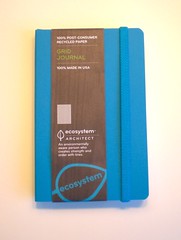
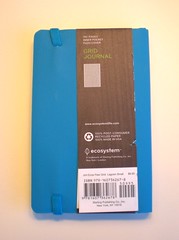
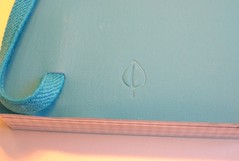
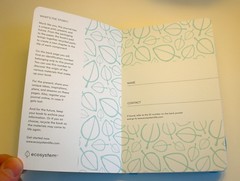
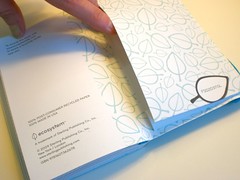

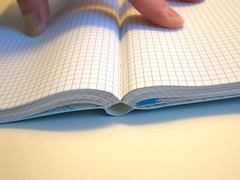

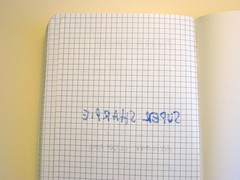
The struggle to successfully promote and level out the economic realities of an American-made, post-consumer paper product that can compete with Asian imported goods must seem insurmountable to the Ecosystems proprietors.
I received a hardcover in watermelon as a gift and if I didn’t have a bookcase full of empty notebooks I’d be buying several more.
I am convinced there is a much more interesting story behind this company than they’re letting us see on their site. A visit to one of the assembly plants and an extensive interview would be cool. Find the funding and I’ll shoot the video documentary needed to tell their story.
david boise ID
This looks like a cool notebook but I agree that the grids are way too dark. Ruled or blank for me. And it looks like it holds up to fountain pens (my passion).
I would both register and write my contact information in mine. I’ve lost a notebook and totally stressed out about it until it was found. But what I keep in my books is very valuable to me but no one else. To each their own, eh?
Here’s a Flickr photo set of the Ecosystem notebooks being made at their plant in Maine:
http://www.flickr.com/photos/ecosystemlife/4115162599/in/set-72157622707134363/
I think it’s fabulous that they are making the effort to create an ecologically sound product in the U. S. I use their pocket cahiers and have been very pleased with them. I like the paper and they are very sturdy. The only thing I don’t care for in the journals (the pocket sized and the larger sized) is that all the pages are perforated. The perf is pretty strong, and I have yet to have any pages in the cahiers come out unless I want them to, so maybe the journals would be equally likely not to tear out accidentally. Nevertheless, there’s something that says “impermanent” about perforated pages; not what I would want in a journal.
thanks for the review. it helps to make an informed decision when making such an important purchase! i too like decorative end papers.
Great review! My two cents on the perforated pages – I LOVE them!
Some independent bookstores may carry Ecosystems, too. Mine does. But I think I will prefer Moleskines for many of the reasons mentioned here, including not lying flat, and the bright white pages with dark lines. Moleskine’s cream pages with gentle gray rule is more how I roll.
Glad to see you gave these a second chance, I really like them. And honestly I dont mind the pushing of the environmental and “made in the US” type stuff on these because they seem like very legitimate claims…there are many worse things that companies push. :)
Perforated pages ruins the notebook for me. I love the colors but like something more permanent so my journals can last while I’m living.
Now that I found out Moleskine is made in China I will definitely move to Ecosystems.
The smaller notebook size is so wonderful — it’s a shame that the grid paper seems to clash with everything except a bold black sharpie! I hope they really consider larger squares or much lighter (possibly colored?) ink for their grid notebooks. They’re unusable otherwise.
This may be a new development, I dn’t know. If you look at the very bottom of the Ecosystems’ main page, it says:
“© 2010 Sterling Publishing Co., Inc., A wholly owned subsidiary of Barnes & Noble. All Rights Reserved.
No that there’s anything wrong with that.
david boise ID
B&N has owned Sterling for quite a while, that is why you don’t see their books (or these Ecosystem notebooks) in many other retailers but B&N. They don’t try that hard to sell them to other stores, and most other retailers don’t want to buy them anyway, because they’d be supporting the competition.
I walked in to Barnes & Noble to purchase yet another journal, and as I approached the display of what has become my preferred standard in journals—the Moleskine—I stood, aghast…
There, on the display case, rested a sign: “Warning: This product contains a chemical known to the State of California to cause cancer, birth defects and other reproductive harm.†I bolted for a sales associate seeking confirmation of this hideous discovery. I’ve been a long-time user of Moleskines (journals and planners), and have always appreciated and respected them for their quality products. Of course, now they’re made in China. I should have expected a decline in quality, and should have suspected toxins would be present in the product, as well. I quickly got on my laptop to further research my discovery, and sure enough, found loads of information on the topic. Even the Moleskine website is required to post the warning. The toxin is DEHP (Bis(2-ethylhexyl) phthalate), a type of plastic softener used in all Moleskine notebook covers. As of August 2010, Moleskine has yet to release DEHP-free notebooks. (And all this time I’d wondered why the Moleskine display was so well-stocked…the sales associate informed me that sales of the products have dramatically decreased in the past six months for obvious reasons, since the warning was posted).
Naturally, I began my quest for a replacement. I was more than absolutely delighted to discover Ecosystem journals and planners. They are designed EXACTLY like the Moleskines, but BETTER, because:
The cover contains 100% post-consumer recycled paper stock, dyed with vegetable-based ink
The paper is post-consumer, acid-free, process chlorine-free paper stock, printed with vegetable based inks and utilizing environmentally-friendlier adhesives
The outer elastic closure and inner ribbon bookmark is made of 100% organic cotton
…and sweetest of all, it is 100% handcrafted in the U.S.A., by our fellow countrymen.
And all of this matters to me. I am, by no means, a tree-hugger, but I am concerned about our environment and want to do my bit to protect and preserve it. I also feel much better about the fact that Americans were employed to proudly craft these products. It doesn’t get much better than this!
These journals and planners are amazing—stellar quality, durability, smart format, and just a joy to own. Definitely one of my newest treasures.
Happy journaling,
Cate
Ahh…Ecosystem notebooks. I just went crazy and ordered 15 of them on Amazon, at good discounted prices, by the way.
I ordered the 5 available colors, in each of the three sizes. They are blank, with flexicovers.
This, although I have literally dozens of handsome notebooks which I haven’t used.
It’s making me anxious. I want to organize SOMETHING in those neatly arranged categories of color and size. Can’t just use them randomly. I want some kind of system of logging, keeping track of something, some kind of special lists, something.
What do you all do when you are compelled to buy more notebooks than you can use? I’m not kidding about the anxiety. I feel that perhaps my subconscious is telling me to start writing, but other than the journal-y things, WHAT???
I have been surfing online greater than 3 hours lately, yet I never discovered any attention-grabbing article like yours. It?s pretty worth enough for me. In my opinion, if all web owners and bloggers made excellent content as you probably did, the internet will be a lot more useful than ever before.
I couldn’t agree more about the grids being way too dark but I think the size is perfect. I’d rather have smaller squares than larger. Larger can always be made from the smaller, but not the other way around.
I worry about the perforations holding up over time though. It seems like the pages naturally bend along the perfs when I open the book.
Thanks for posting this review. The information you provided has been very helpful, especially pointing out the perforation (which is not easily said on the product website) and the bleed-through.
I have been trying for weeks to purchase an ecosystem notebook, but the B&N website says that their out-of-stock. Will they ever be back in stock?
Just wanna input on few general things, The website layout is perfect, the articles is very superb : D.